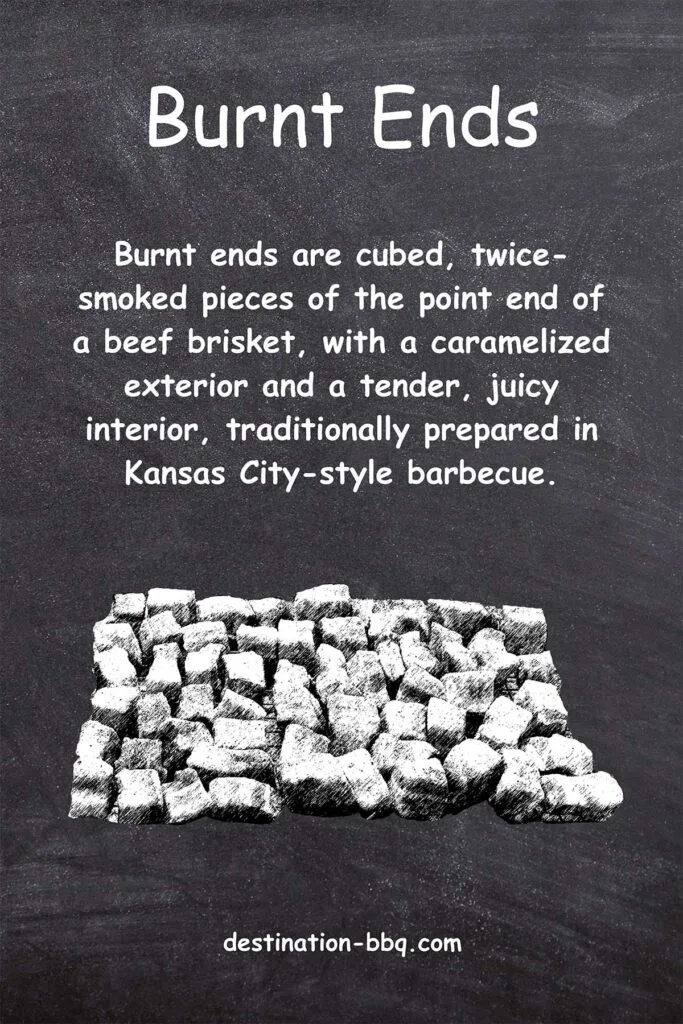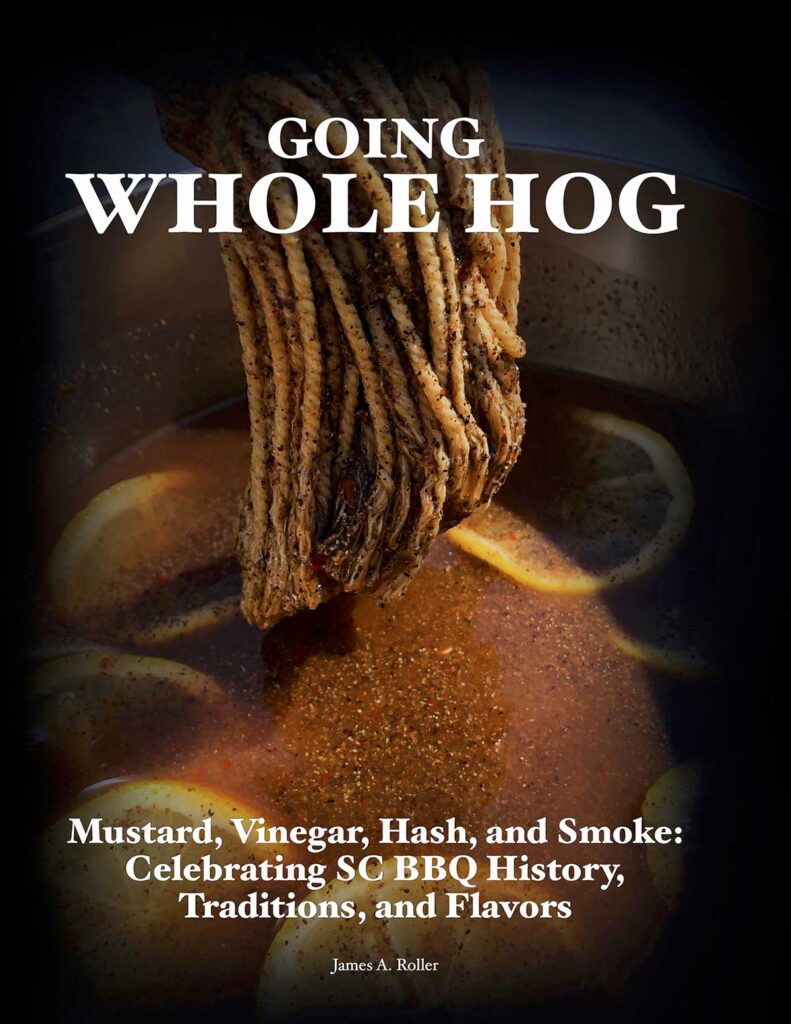
What are Burnt Ends?
Burnt ends are a specialty of Kansas City-style barbecue, traditionally crafted from the point end of a smoked beef brisket, a section known for its higher fat content. These cubes of meat are smoked twice, first as part of the whole brisket, and then again after being cubed, resulting in a characteristic charred exterior and a juicy, tender interior. Coated with a sweet and tangy barbecue sauce that caramelizes during cooking, burnt ends have evolved from throwaway trimmings to a sought-after barbecue delicacy, appreciated for their unique flavor and texture.
Key Takeaways
- Burnt ends, originating from Kansas City-style barbecue, are made from the fattier point section of a smoked beef brisket.
- They are traditionally prepared by a two-step smoking process, first as a whole brisket, then as cubed point-end pieces to achieve a “burnt” exterior and tender interior.
- Historically considered as byproducts, Arthur Bryant’s Barbecue in Kansas City popularized burnt ends, transforming them into a barbecue delicacy.
- They are typically served coated in a sweet and tangy barbecue sauce, either alone or as a flavorful addition to sandwiches and other dishes.
- While beef brisket is traditional, contemporary variations of burnt ends feature different cuts of meat, including pork belly and chuck roast, expanding the realm of this barbecue favorite.
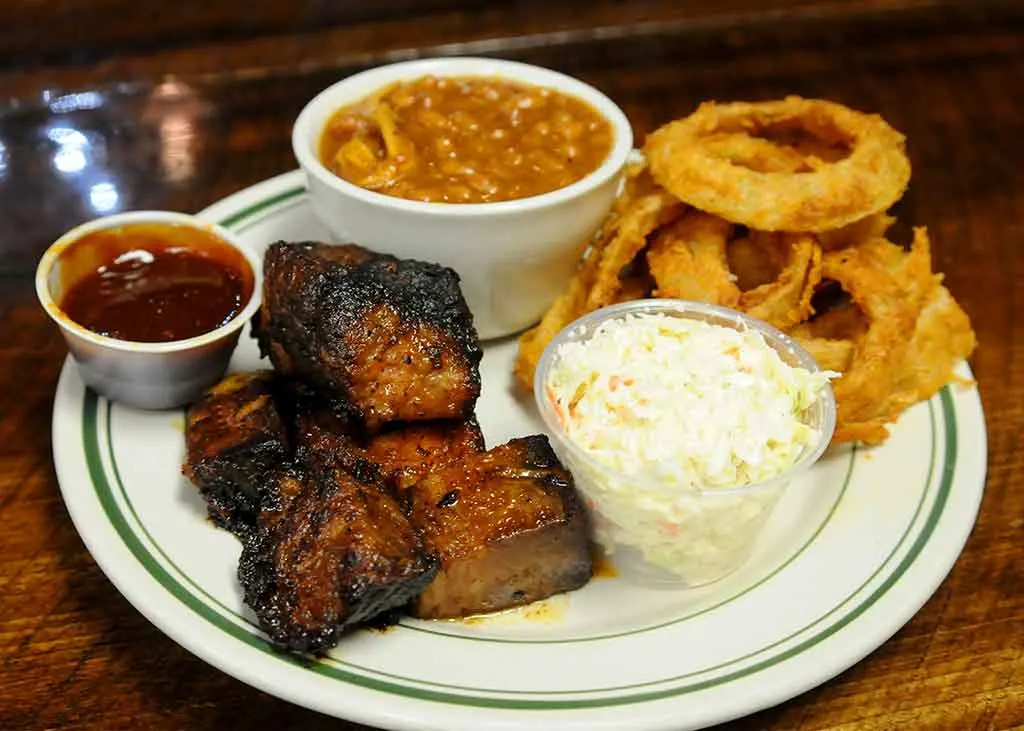
Kansas City deserves all the credit for one of barbecue’s greatest inventions: the burnt end. These are the crusty ends from the fatty side of the brisket that are cubed into bite-sized morsels. They’re sometimes re-seasoned and/or sauced, then smoked further to get more tender and a bit crunchy around the edges. Kansas City basically has burnt ends (okay, and ribs) to thank for being considered a bonafide regional style of American barbecue.
Daniel Vaughn, Texas Monthly
Understanding Burnt Ends
Burnt ends have a deep-rooted history in the world of barbecue, specifically originating from the Kansas City barbecue tradition. The ends of a brisket are thinner than the middle part and, as a result, cook faster in the smoker.
Over time, these end pieces become crunchy, heavily caramelized, and intensely smoky, creating a unique flavor and texture that has become an iconic part of Kansas City’s culinary landscape.
Traditionally, these end pieces were not considered suitable for sandwiches and were often discarded during the brisket preparation process. However, the distinct taste and texture of burnt ends soon gained attention, and they became a popular standalone dish, often smothered in barbecue sauce.
Today, they can be found not only as a main dish but also served as a part of various other dishes, such as baked beans and hearty sandwiches.
They are usually served chopped, with sauce on top or on the side, and should display a modest amount of “bark” or char on at least one side, signifying their authentic origin.
The widespread popularity of burnt ends has made them a staple in the American barbecue scene, and they continue to be a beloved snack for barbecue enthusiasts across the nation.
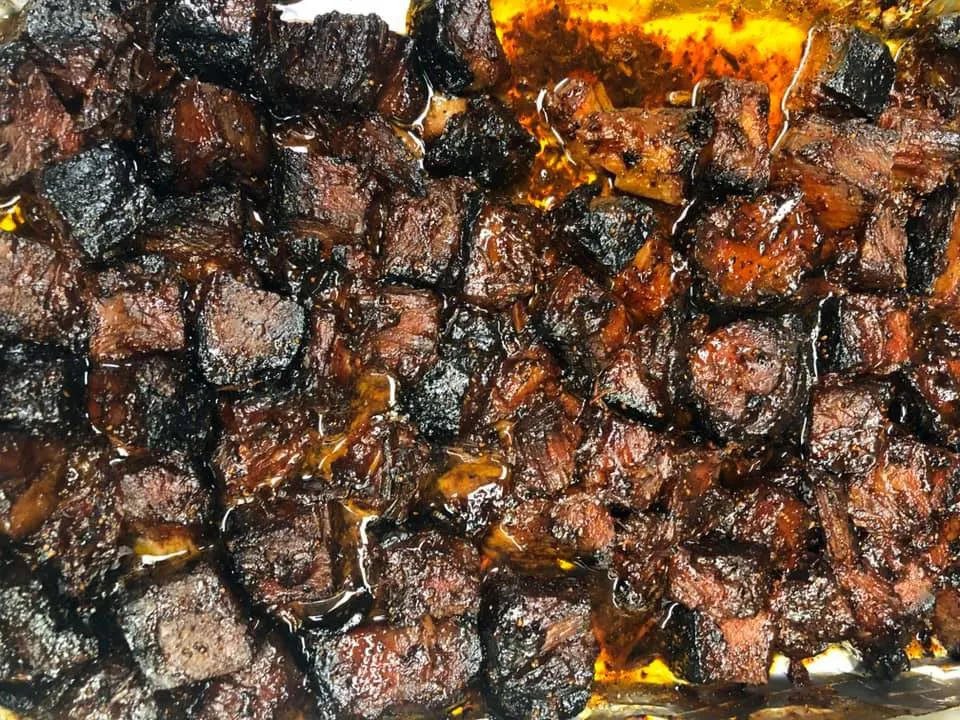
History
The history of burnt ends is deeply rooted in the tradition of Kansas City-style barbecue. Arthur Bryant’s Barbecue, a famous barbecue joint in Kansas City, is often credited with their popularization. Arthur Bryant would smoke whole briskets, chop them into pieces, and then serve a mix of the leaner and fattier parts – the latter being the now-famous “burnt ends.”
Initially given away or used in stews, these charred, fatty pieces soon caught the attention of customers who appreciated their unique texture and robust flavor. Over time, these incidental leftovers transitioned from being seen as throwaway bits to becoming the star attraction.
Maybe the first to make the public aware of the joys of “burnt edges” was writer Calvin Trillin who wrote about them in a 1972 Playboy article describing his culinary tour of Kansas City. Trillin’s article helped make Kansas City a barbecue destination, but the burnt ends he described are not the same as the ones served in restaurants today.
“The main course at Bryant’s, as far as I’m concerned, is something that is given away free – the burned edges of the brisket. The counterman just pushes them over to the side and anyone who wants them helps himself,” Trillin wrote.
“I dream of those burned edges. Sometimes, when I’m in some awful, overpriced restaurant in some strange town, trying to choke down some three-dollar hamburger that tastes like a burned sponge, a blank look comes over me: I have just realized that at that very moment, someone in Kansas City is being given those burned edges for free.”
Preparation and Cooking
The traditional choice for burnt ends is the brisket point. This is the fattier and more marbled section of a full packer brisket. The marbling and fat content make it perfect for rendering down during the smoking process, leaving behind tender, moist cubes of meat.
To be clear, brisket is made up of two primary parts: the point and the flat. The point is the thicker, fattier part of the brisket, and the flat is the thinner, leaner section. Both parts are layered together with a layer of fat in between.
The point, with its higher fat content, becomes incredibly tender and juicy when cooked properly, making it the preferred section for burnt ends.
The traditional method of preparing this dish involves smoking a whole beef brisket until it’s tender. After the initial smoking, the point end of the brisket is separated from the flat, cubed, and then returned to the smoker for additional cooking time.
This process allows the cubes to develop a crispy exterior while maintaining a tender interior. The result is a mouth-watering balance of textures.
After smoking, the cubes are typically tossed in a sweet and tangy barbecue sauce, which caramelizes onto the meat and adds a further layer of flavor. The Gates and Son’s BBQ sauce recipe works well.
While the traditional dish is made from the brisket point, variations using different cuts of meat are not uncommon today.
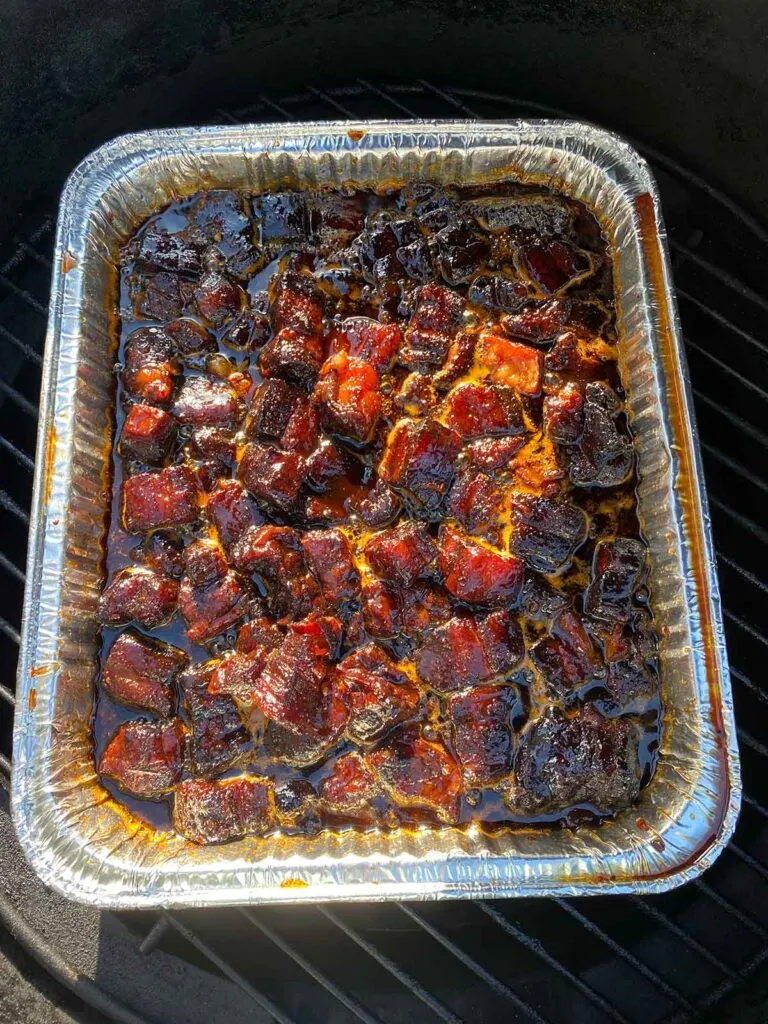
Photo courtesy of Jason Pryzbyla
Variations
As the popularity of burnt ends has expanded beyond Kansas City-style barbecue, variations using different cuts of meat have emerged, providing intriguing twists on the traditional brisket version.
Particularly noteworthy are pork belly burnt ends and chuck roast burnt ends, often dubbed “Pork Belly Candy” and “Poor Man’s Burnt Ends” respectively.
Pork belly, when cubed and smoked, yields a version that is decadently rich and tender, often compared to meat candy due to their sweet, smoky flavor profile.
On the other hand, chuck roast, a less expensive cut than brisket, provides a more accessible entry point into the world of burnt ends, yielding a product that, while not as rich as brisket or pork belly, still carries a robust, smoky flavor that does the tradition proud.
These variations demonstrate the versatility of the burnt ends concept and its adaptability to different types of meat.
Serving and Consumption
Burnt ends are versatile and can be served in various ways. They can be enjoyed on their own, allowing the eater to fully appreciate the rich, smoky flavor and contrasting textures. Alternatively, they can be served in sandwiches or as an addition to other dishes for an extra punch of flavor.
Cultural Significance of Burnt Ends
Burnt ends have become a hallmark of Kansas City-style barbecue and an embodiment of the transformative power of slow, careful cooking. What was once considered a lesser cut is now a sought-after specialty, demonstrating the barbecue ethos of making the most out of every part of the animal.
Today, their popularity has spread beyond Kansas City, and burnt ends can be found on the menus of barbecue joints across the globe, serving as a testament to the international influence of Kansas City-style barbecue.
Final Words
Burnt ends, with their crispy exterior and juicy interior, offer a unique culinary experience that has won the hearts of barbecue enthusiasts worldwide. From their humble beginnings as throwaway bits at a Kansas City barbecue joint to their current status as a barbecue delicacy, burnt ends exemplify the potential for incredible flavors and textures that can be achieved through the art of slow cooking.
